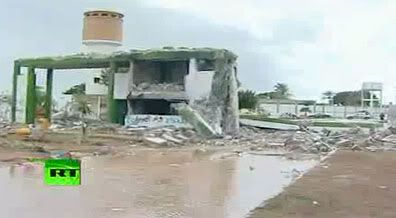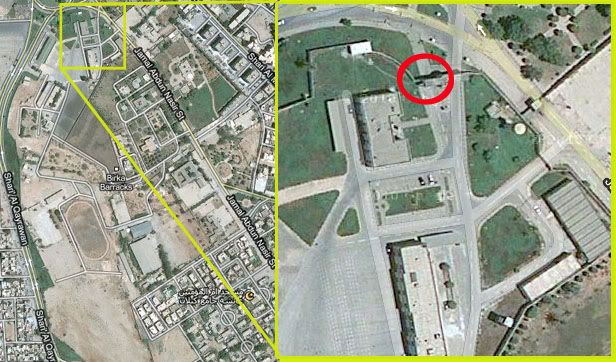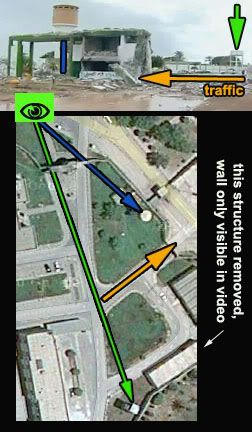September 10, 2011
last edits, Sept. 29
The Order to Kill Demonstrators: Generally Accepted
Huge neon question marks have by now been affixed, usually to the less-visible back sides, of most of the constructed accusations of the Libyan propaganda war. Human Rights Watch and others have repeatedly found against African mercenary claims, Amnesty International and others have found no basis for the general mass rape charges (adding Viagra to the mix seems to done the field in). Even the US military acknowledged there was no evidence of aerial bombardment of Libyan cities and protesters as widely alleged, when there really should have been some. The emotionally potent charge of Children shot by Gaddafi snipers in Misrata might sound compelling, but anyone with the two shown x-ray images can see they're the same, fake, image (see link).
But one crucial accusation, the first and perhaps tallest construct, looms over the rest with no flashing sign yet, remaining generally accepted, even among such critics: the government order to shoot at peaceful demonstrators simply for daring to protest. The charges of doing so from the air are rightly ridiculed, but few go as far as I will here and directly question whether it was done from the ground either.
It's not a patently ridiculous claim, and one supported by numerous injured civilians we were shown. No one can deny that people who are described as protesters were injured and killed by live fire, at different times and places, often vague. Some were even cut in half (by anti-aircraft guns it's said) in pictures I've seen. At first, I myself accepted the basic accusation, thinking Gaddafi just didn't play the Arab Spring game. If his populace was to be weaponized against the "revolution" by the usual Western conspirators (as I'm sure he'd suspect after following events of the past decade) he'd move to destroy their weapons. You simply kill some, and hopefully send the others running in fear. It surely wouldn't have been the first time an unfree state used such sheer force to stay that way.
But while there is plenty of precedent, and proof of injured and killed people to support the accusation, what's never been scientifically proven (supported by clear video evidence, for example) is the exact circumstances of this violence - where were these civilians at and what were they doing when damaged so? The question is a complex one, and perhaps impossible to settle decisively. I've been considering this question but haven't until now created a dedicated post to best address it in one spot. Now that it's up, you can see why - it's a doozy of a post.
The Government Story: Defending Bases
We all know the official story in the international community, almost universally accepted at the moment: the insane and ruthless col Gaddafi ordered his citizens slaughtered for simply defying his rule, but damnit, now we would defy it too. They were simply protesting in some peaceful protest place when it happened. They did nothing to provoke or necessitate the violence they suffered. Troops fired indiscriminately, killing women and children, people not even protesting. They had snipers shooting those who tried to retrieve the dead, and so on. They did so consistently enough it couldn't be the actions of rogue commanders, but had to be an order from on high, presumably from Muammar Gaddafi himself.
This primordial sin, almost universally perceived worldwide, was the basis of Gaddafi's forfeiture of legitimacy in the eyes of world leaders. The exact death toll was always vague, but presented as alarmingly high and likely requiring some intervention. (note: the exact death toll is not clear, is important, but is not addressed here. This is about the qualities of death, not quantities.)
But below is, first, a video I made a while back, and then some text, that seek to first explain and then explore the Libyan government's own version, which hardly anyone's heard except maybe in passing derision.
In the video, government spokesman Moussa Ibrahim can be seen at a February 28 press conference explaining their view, as opposed to that of "the media and the UN." At the beginning, there were "genuine, Libyan, peaceful protesters" with what he called "legitimate demands" for "much-needed political improvements." Some of them also waved the old monarchist flag while insisting that Gaddafi step down, which the government would not call a legitimate demand. But they weren't shot for anything they said, Ibrahim asserted, legitimate or not. This only happened after the protests were "hijacked" by violent Islamists, including members of al Qaeda, into a physical attack on Libya's government and people.
"[The Islamist-led "protesters"] immediately moved to attack and acquire weapons from police stations, army camps, and munitions depots. [...] the fights between the security forces and the armed individuals caused the deaths of hundreds of people. We never denied that hundreds of people were killed in the last few days. But those people were from both sides, and as a result of armed individuals attacking police stations and army [barracks] [...] the army and the security forces were not trained to deal with such a dramatic turn of events."Also in the video, the leader's son Seif al-Islam Gaddafi says a total of 159 people, presumably on the civilian side alone, were killed in the rebellion's first days. "Most of them died when they attacked military sites," he said. This is from a July interview with Russia Today, in which he again denied any order to kill protesters, and explained the cause of the shooting so:
"The guards fired. That's it. The gurads were surprised by the attack of the people, and they started firing. They don't need an order to defend themselves and to defend their bases and camps."As he rightly noted, this is standard for any country in the world, should armed and angry mobs attack a secure installation. The idea seems to be to avoid enemies, foreign or domestic, from killing your forces, sabotaging your hardware, or worse yet stealing your hardware. Because then it can be used to attack more bases in furtherance of a violent civil war, as the Libyan government alleges happened repeatedly in their country from the early days onward. The explanation fell on deaf ears (or hard-of-hearinng ones - see below).
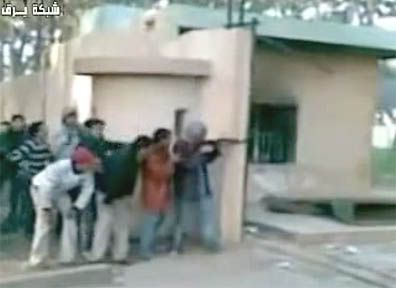 Just for one example of an even softer response, protesters filmed themselves firing their guns into a military base around Feb 21, and suffering no violence themselves. But they did cheer with gunshots in the air as an ambulance took out someone injured inside. (see video study here) A documentary by R. Breki Goheda, based on the government's version with detailed information, shows this same camp (perhaps near Misrata), before it was finally taken by the armed civilian gang. Inside the opened gates, we can see in the distance soldiers standing at the alert, clustered with vehicles. Goheda's narration says they "refused to open fire at protesters," and instead only "opened fire into the air as the attackers were advancing in the barrack." It's said the protesters won there, as they seem to have everywhere else with a strange confidence against a bewildered enemy, in what Goheda artfully termed an "organized and coincident process."
Just for one example of an even softer response, protesters filmed themselves firing their guns into a military base around Feb 21, and suffering no violence themselves. But they did cheer with gunshots in the air as an ambulance took out someone injured inside. (see video study here) A documentary by R. Breki Goheda, based on the government's version with detailed information, shows this same camp (perhaps near Misrata), before it was finally taken by the armed civilian gang. Inside the opened gates, we can see in the distance soldiers standing at the alert, clustered with vehicles. Goheda's narration says they "refused to open fire at protesters," and instead only "opened fire into the air as the attackers were advancing in the barrack." It's said the protesters won there, as they seem to have everywhere else with a strange confidence against a bewildered enemy, in what Goheda artfully termed an "organized and coincident process."
The Video Record: No Proof Either Way
Secretary of State Clinton said on February 28, in support of vigorous action against Libya, "we have seen Colonel Qadhafi’s security forces open fire on peaceful protesters again and again." Unless she and some associated "we" have access to secret videos and photos the rest of us don't, she's simply incorrect. We have seen it reported and alleged time and time again, but that's just not the same thing.
The first problem I noticed in comparing Tripoli's explanation and that of the rabble forces was a lack of video proof either way.
The proof of the government's side might have been base security camera tapes, but these aren't likely available to them after each of the facilities was taken over. Whereas if the "protester" version was true, there would not likely be any lack of such proof; they'd end up with the tapes from the bases. And more importantly, the crowds had many, many iPhones and other cameras everywhere they went, and aside from their proud excursions into racist snuff films, we see in their recordings people protesting, and then civilians injured and dead. There should be several videos, probably dozens, showing the crucial middle part - some of those hundreds of peaceful protesters visibly knocked down by government bullets. Instead we have three that I know of, discussed next. (see: Video Study: Protesters Being Shot, Anywhere)
The proof of the government's side might have been base security camera tapes, but these aren't likely available to them after each of the facilities was taken over. Whereas if the "protester" version was true, there would not likely be any lack of such proof; they'd end up with the tapes from the bases. And more importantly, the crowds had many, many iPhones and other cameras everywhere they went, and aside from their proud excursions into racist snuff films, we see in their recordings people protesting, and then civilians injured and dead. There should be several videos, probably dozens, showing the crucial middle part - some of those hundreds of peaceful protesters visibly knocked down by government bullets. Instead we have three that I know of, discussed next. (see: Video Study: Protesters Being Shot, Anywhere)
While the government's got no video of these base attacks either, one protester video at least provides a decent support for Tripoli's claims of repeated armed attacks. It's widely illustrated that on consecutive days, February 17-20, protests and/or funeral processions in Beghazi turned somehow into violent clashes with deaths on both sides. It probably didn't help that these kept happening next to the Al-Fadhil bin Omar Katiba barracks, Benghazi's main military base in the city's center.
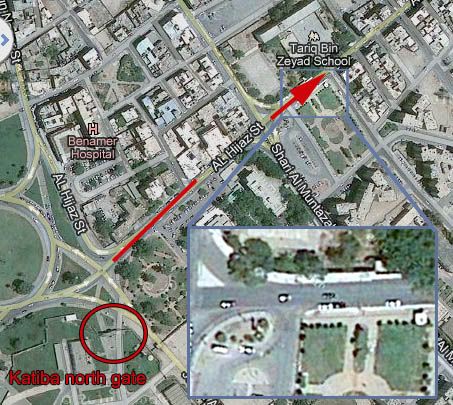 On the third day, February 19, we have video of two injured "protesters," one apparently just deceased, the other being carried up a street from somewhere to the west-southwest, away from the setting sun. The spot it's filmed was identifiable in satellite imagery, and proves the injured man was being carried down al-Hijaz street, away from the Katiba's valued north gate four blocks back. (see map at left, and the post February 19's death toll in Benghazi for more details). Keep that north gate in mind - it comes up again in the conquest by "protest" of that base on the following day.
On the third day, February 19, we have video of two injured "protesters," one apparently just deceased, the other being carried up a street from somewhere to the west-southwest, away from the setting sun. The spot it's filmed was identifiable in satellite imagery, and proves the injured man was being carried down al-Hijaz street, away from the Katiba's valued north gate four blocks back. (see map at left, and the post February 19's death toll in Benghazi for more details). Keep that north gate in mind - it comes up again in the conquest by "protest" of that base on the following day.
 On the third day, February 19, we have video of two injured "protesters," one apparently just deceased, the other being carried up a street from somewhere to the west-southwest, away from the setting sun. The spot it's filmed was identifiable in satellite imagery, and proves the injured man was being carried down al-Hijaz street, away from the Katiba's valued north gate four blocks back. (see map at left, and the post February 19's death toll in Benghazi for more details). Keep that north gate in mind - it comes up again in the conquest by "protest" of that base on the following day.
On the third day, February 19, we have video of two injured "protesters," one apparently just deceased, the other being carried up a street from somewhere to the west-southwest, away from the setting sun. The spot it's filmed was identifiable in satellite imagery, and proves the injured man was being carried down al-Hijaz street, away from the Katiba's valued north gate four blocks back. (see map at left, and the post February 19's death toll in Benghazi for more details). Keep that north gate in mind - it comes up again in the conquest by "protest" of that base on the following day.
To be sure, some of Muammar Gaddafi's and the Libyan government's claims, freely mixing al Qaeda, foreigners, mass drugging, mass rape, cannibalism, and CIA manipulations, are questionable at best. But the part about a violent and apparently orchestrated turn of events is well supported. Any government would probably have responded at least as harshly as Libya's did.
No Proof, but Evidence: Exceptions to the Rule?
Seif al-Islam said "most," not "all," of the killed civilians were involved in attacks. We don't know what "most" means from their point of view, but there do seem to be exceptions to the rule.
There are two instances I'm aware of (and I admit my knowledge there isn't exhaustive) of apparently unarmed civilians shot dead on camera. These both happened during a funeral march on a certain street in al Baida on February 17, and were captured by three cameras, one from street level and two from above. I've analyzed the videos and collectively, they show two unarmed people shot down in the street, at different times, some distance from a line of armed police/soldiers at the end of the street.
No other gunmen are visible from these rooftop views or from the ground view (except maybe a couple), so the presence of security men in the area, some would argue, is enough to demonstrate the pattern alleged. But some evidence supports my strange hunch that anti-government snipers on rooftops - apparently next to the cameras filming - were responsible.
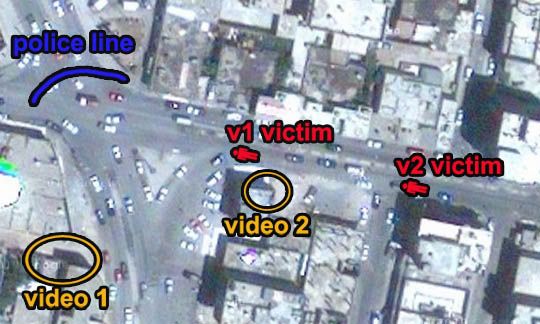 There's video 2's strange camera move to consider - popping from behind a possible sniper nest to film the crowd again just as the shot is fired. And there's the possible rifle on that same rooftop filmed by a another camera (video 1 as listed). And then consider the line of sight. Each of the two protesters were shot as they came into camera view, which is also the line of fire for any sniper in the same location.
There's video 2's strange camera move to consider - popping from behind a possible sniper nest to film the crowd again just as the shot is fired. And there's the possible rifle on that same rooftop filmed by a another camera (video 1 as listed). And then consider the line of sight. Each of the two protesters were shot as they came into camera view, which is also the line of fire for any sniper in the same location.
But my theory, even though better illustrated than I thought it would be, is not proven. But these possible sniper clues hover above all three of the videos and both filmed victims of unprovoked shooting that I know of. I will leave this space open for any other excepions to, or refutations of, "the rule" that I run across or have suggested. Evidence of apparent state brutality like these videos is not proof, but it is worth a look, and I challenge any reader who thinks I must be wrong to please dig around for anything to support that hunch.
Defiance of the Order as Evidence of the Order
One of the more powerful illustration of the alleged commandment to massacre was the repeated allegation of government soldiers executed for refusing to follow it. We only know of this because their bound and executed bodies were then found by protesters with a magical knowledge of just why they'd been slain - "because they would not commit the brutality commanded to them."
On February 23, a total of 130 soldiers were reported by a sham Human Rights group as executed like this and for this reason across Eastern Libya. There was no evidence to support that, and enough against to disprove it in at least 27 cases. First, 22 soldiers executed by rebels, as their own video proves, were boldly blamed on the regime for "refusing to fire on civilians," and included in the 130. Ironically, their rebel-issued death sentence has been translated as based on the fact they DID shoot at the armed people attacking their base (apparently Labraq airbase).
And another, more horrific case of fobbed-off rebel brutality, presumably also included in the same 130, concerns another five "soldiers" found charred in the conquered barracks in Benghazi. This find occurred on February 21, right after "protesters" there had burned to death five innocent men from Chad. That's 27 so-called mutinous soldiers executed. The oher 103 we just don't know the details, but the patterns illustrated so far do not line up with what the rebels asserted.
Evidence by executions, claimed by rabble forces, when the killings are demonstratably carried out by them, clearly does nothing to support their own claim. In fact, it goes strongly and ingeniously towards disproving altogether the legend of the order to cut down peaceful protesters.
Maj. Gen. Younes, Deadly Force, and the Benghazi Katiba
In his Russia Today interview, Seif Gaddafi explained how his reaction to news of massacres in his country was to get ahold of the man in charge of internal security - the interior minister, Maj. Gen. Abdel Fateh Younes.
"My father called the general Abdel Fatah - he's in Benghazi now - he's one of the leaders of the rebels. He called him, and I called him, and the calls are recorded. We told him many times: "don't use force with people." He told us: "but they are attacking the military sites. It's a very difficult situation."Younes apparently won that dispute, and by the 20th, as Benghazi teetered on the brink, the secretary himself rolled a major reinforcement in personally, ready to negotiate or fight. Instead he defected, marking a major turning point in the war no one even knew was a war yet.
He was sent to re-enforce the Al-Fadhil bin Omar barracks. Many sources agree the base was decisively takend Feb 20, following an attack by a suicide car-bomber who'd blended into the fourth day of funeral processions-turned-to-battles there. After he destroyed the valued north gate with a truly powerful explosion (also not seen on any public videos), the insurgents were able to enter the base full-force. They reportedly killed an unknown number of soldiers, beheading at least one, before Younes had even arrived. The remainder, holed-up in various buildings, were spared and allowed to leave only by the bargain Younes struck that night.
The French terrorism and intelligence groups CIRET-AVT and CF2R made a joint investigation in Libya and issued a report in May, 2011. Speculating on reasons for the lack of protester shooting they saw evidence for, they offer a little conspiracy theory about the eventual star defector:
The government, surprised at the escalation of the insurgency, did not want to start a blood bath, so as not cut themselves off from the tribes, nor to create the problem of vendetta (revenge.) It is not inconceivable that the interior minister (Abdel Fatah Younis) deliberately gave orders to do nothing, so the insurgency could take hold, from the perspective of his imminent departure for Benghazi.That is, perhaps Seif was lying and such an order was issued, but blocked by Younes. Either way, if there was such an order from on high, it didn't get sent down the chain, judging by the evidence - and lack thereof - for its execution.
They did get the Weapons
The first thing that really struck me as odd about the first days of the civil war is how non-violent protesters, whom I believed were being shot dead in droves, were able with just anger, and despite the heavy losses, simply take military control, even briefly, of half of the cities in the country. I sensed we were missing something there, and the things I've found since are starting to reveal what that was.
The "protesters" did, starting on February 19 at the latest, acquire heavy weapons of war from military bases they somehow conquered, despite just protesting. For just one important example, the Katiba in Benghazi remained in protester hands thanks in part to Younes' defection. But as they made off with many many more weapons, it was civilians doing the driving and handling, not military professionals. These were happy just to be allowed to leave the scene alive, in the opposite direction.
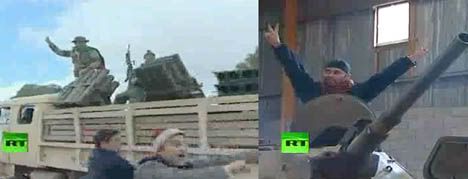
Some of the hardware taken from the Katiba is seen at left from a Russia Today news video - tanks, Grad rocket launchers, and more. Other weapons taken from Zintan to Zawiyah, Misrata to Dernah, were shown in other videos made by protesters, and largely included in my own video up top.
Goheda's video explains that "rebels stormed most of the military camps in the country," along the way seizing "different types of weapons, including: 250 tanks, 72 armored vehicles, 112 artillery, 176 anti-aircraft machine guns, 254 rocket launchers, 222 light machine guns, 3,628 rifles, and a large quantity of ammunition." I can't vouch for all of that, but it sounds about right considering the small samples we've been able to see of rebel arsenals coming together all across "Free Libya" in those early days and weeks.
Every time a new city center saw its display of rebel-held weaponry, the "freedom fighters" would trumpet that the military there had defected, bringing their weapons along. We see claimed defectors in original uniforms and such in a few videos, and some later in rebel non-uniforms. The people holding the weapons are usually clear amateurs so excited to be armed like Rambo they can't help but fire into the air incessantly. Consider this video analysis by C.J. Chivers; not a person on the crew running this artillery piece in Misrata knew they were standing ten times too close to that wall for safety. At least two rebel fighters were injured by the sloppiness, including one whose femoral artery was severed and who likely died soon after. (But they did the job - the place they were blasting was like swiss cheese, and had several very destroyed government soldiers and a mysterious charred boy inside.)
Brutality and the Boys in Blue
Libya's Internal Security Organization, being the usual force to control and deal with crowds and riots, would have been the main people expected to fire on protesters on, before, and after the "Day of Rage" that brought "peaceful protesters" out to tear down the state. It was Internal Security who held that line in al Baida, and were blamed for the shootings of the 17th and many others. But according to Goheda's video, they were given orders "not to open fire under any circumstances." Other than the al-Baida videos discussed above, I've seen no evidence to counter that.
Another video I made:
The CIRET-AVT/CF2R report cited above also discussed the three weeks in which az Zawiyah, just west of the capitol, remained in protester hands unmolested. “During the three weeks, the police received written orders not to do anything against the insurgents, not to shoot, not to confront them. The police also had to evacuate their own buildings due to the attacks by the rioters. […] The local authorities and the police complained openly about the absence of orders from Tripoli…” As for what happened during those weeks, I have a great analysis here, and the report added:
[A]ll public buildings were pillaged and set on fire. [...] Everywhere, there was destruction and pillaging (of arms, money, archives). There was no trace of combat, which confirms the testimony of the police [who claim to have received orders not to intervene] [...]
There were also atrocities committed (women who were raped, and some police officers who were killed), as well as civilian victims during these three weeks. [...] The victims were killed in the manner of the Algerian GIA [Armed Islamic Group]: throats cut, eyes gauged [sic] out, arms and legs cut off, sometimes the bodies were burned. [...]
The United Nations Human Rights Council sent a three-person fact-finding mission to Libya in May to investigate the alleged crimes of the regime and/or rebel forces. They issued a report (the Advance unedited version is still the only one available - PDF link) on June 1 that came out at least somewhat more reasonable than what the rebel-fed Media had so far patched together. They explain how the charge of Gaddafi's protester massacre was their primary focus:
The catalyst for establishment of this Commission of Inquiry was concern over the use of force against demonstrators in mid to late February. The Human Rights Council in Resolution S-15/1, expressed “deep concern at the deaths of hundreds of civilians,” referring also to “indiscriminate armed attacks against civilians” and “extrajudicial killings.”[p3]What they found confirmed, to their satisfaction but not mine, that there were apparently orders to kill peaceful protesters. From their conclusion:
99. The Commission considers that there is sufficient evidence to suggest that the Government forces engaged in excessive use of force against demonstrators, at least in the early days of the protests, leading to significant deaths and injuries. The nature of injuries inflicted in several locations (with high proportions shot in the head or upper body) is indicative of “shoot to kill” operations. From the common style of response in many parts of the country, it would appear likely that the forces were given orders to engage in the harsh crackdown of demonstrators. Such actions represented a serious breach of a range of rights under the ICCPR including the right to life, the right to ... [p 37-40]The question, again, is "under what circumstances did these killings happen?" The report does acknowledge the government disputed the prevailing story: "The particular circumstances, leading up to the use of force by security forces against demonstrators, have been contested by the demonstrators and the Government." The latter said what I've related above, and "protestors have reiterated the peaceful nature of their demonstrations." The facts, as I note here, do not clearly support that, but the commission accepted it anyway.
"In the early days of the protest there was little evidence to suggest that the protestors were engaged in other than peaceful assembly," the mission noted. "Little" evidence is a relative call. There's a decent amount and it's consistent. There is even less evidence that those "protesters" who were killed were engaged in anything other than starting an armed insurgency.
The report's relation and refutation of the government story:
96. The Commission was told that when the demonstrations erupted, instructions were given to security forces to withdraw from police stations and security premises. The Government has stressed that the live ammunition was only employed in response to demonstrators’ violent actions. The Government also noted that demonstrators attacked police stations, destroying approximately 17 stations several of them in various cities and towns of Libya, and that demonstrators took up arms against the security forces. The Government was thus of the view that any use of force had been justifiable.Generally they just catalog the numbers of dead as reported, focusing on the shoot-to-kill clues, presuming peaceful actions only on the victims' parts, and accepting every report possible to suggest government forces fired "indiscriminately," often killing people who weren't even involved in protests. The whole way what's missing is any proof their basic presumption of peaceful victims. Since this has not really been established, the report, at least in this regard, is an exercise in faith-based "investigation."
97. The majority of information collected by the Commission, however, indicates that the Government forces used live ammunition against unarmed peaceful demonstrators in many instances.
It is accepted by both the Government and the demonstrators that Government forces used significant force, including the use of firearms and other weaponry against persons participating in demonstrations in various locations within Libya during the period studied by the Commission.Adding "participating in demonstrations" makes this statement untrue. Attacks to secure weapons are not "demonstrations." Scratch that phrase and what they say here is true.
They acknowledge in Misrata, "on 21 and 22 February, demonstrators attacked Revolutionary Committee offices, police stations and military barracks, taking arms and weapons from these locations." But as they heard it, this was only after days of brutal attacks on completely peaceful people who were suddenly, when angry, able to actually take over and remove weapns from military bases - with sheer Arab Spring enthusiasm, we're to presume.
In al Baida, "at least 40 persons were killed during peaceful demonstrations between 16 and 19 February," they noted. Problem is, police station were burnt there as early as Feb 15, anti-government snipers might have been behind any of these killings (and apparently are behind the recorded ones), and by about the 19th, the city and surrounding military bases - including Labraq (or al-Abraq) airbase - were completely in the hands of the "peaceful protesters."
93. On 18 February, at the demonstrations near Al-Abraq Airport (east of Al-Bayda town), the Commission received information that 11 persons were killed by security personnel of Khamis Katiba, including the Commander of Husein al-Jiwiki Katiba. According to several sources, the Commander was killed when he refused to shoot at demonstrators, and was shot as a result of his refusal to shot at demonstrators.Yeah, you'll get "several witnesses" when, for example, several people involved in a killing agree to a cover story. The big clues is the old "killed by his own forces for being a good guy" schtick. It was a lie in the "al Baida massacre," and in the burned soldiers in Benghazi thing, and probably here.
Why do they know it was the Khamis brigade that killed an officer and 11 of their own? Why were they "demonstrating" at the airbase to begin with? The people involved themselves told the media, if not the UN, that they went there, on the 18th, to capture or kill "African mercenaries" they thought were coming to kill them. They took it militarily on about the 20th, after a couple days of fighting, executed some prisoners, and kept 156 black Libyan soldiers alive long enough to be proven not mercenaries. That some of their own were killed in the process should be no surprise, to us or them, prepared as they were for martyrdom.
The claim of government orders to kill demonstrators weren't just on the word of rebel sources but also, the report explained,"corroborated through information collected from some security personnel."
One member of security personnel, currently in detention, stated that he was among 250 soldiers deployed by the regime to “contain demonstrators” in Benghazi on 17 February. Interrogation records provided to the Commission by the Benghazi General Prosecutor’s Office state that members of the security forces were given orders, by their commanding officers, to use force against demonstrators. In at least one transcript, there is an admission of involvement by a member of the security forces in the random shooting of protestors in Benghazi on 20 February.February 20 is the day Benghazi fell, as the Al Fadhil bin Omar Katiba was overrun. The report did pass on that "government opponents assumed control over the Katiba premises in Benghazi," but made no mention of the suicide bomber that allowed that, or of the soldier killings inside. And it even has the date wrong, citing the 19th when the decisive brutality that took 60 lives, by their own numbers, occurred on the 20th, mostly following the suicide bombing and the pitched battle within the walls. Why on Earth was anyone firing randomly that day, when a concerted militant force was attacking the base and hacking off heads?
His "admission" to doing this is just not credible. This claimed evidence from the inside is quite likely the result of forced confessions, and the commission's inability to spot that (or to admit they did) is telling.
The report is deeply flawed. But it formed the basis of explaining why the intervention the UN's top member nations were already deeply invested in was not completely unjustified. In fact, they seem relatively in tune with the existing mission in an accompanying press release, again of June 1:
The team, led by Professor Cherif Bassiouni, an Egyptian jurist and war crimes expert, calls on the Government to immediately cease acts of violence against civilians in violation of international humanitarian and human rights law, and to conduct “exhaustive, impartial and transparent” investigations into all alleged violations.Even if this statement had been issued on February 18, it would have been poison advice to a besieged government. But here it was June, and they called for a current, one-sided cease-fire. There was no mention of the fact that by then the "civilians" were trying their damndest, with half the nation's stolen hardware, and with eager NATO air support, to attack the capitol and everything between. Mr. Bassiouni, like the power structure pushing this war through, was in effect calling for Libya's government to surrender abjectly to the armed insurgency.
This bold move of dubious propriety was based, it would seem to most, on the team's exceptionally clear findings that the government had proven itself brutal to the point of falling outside the normal rules of respect for nations the United Nations was supposed to ensure.
But the reality wasn't really as clear as all that, was it?


